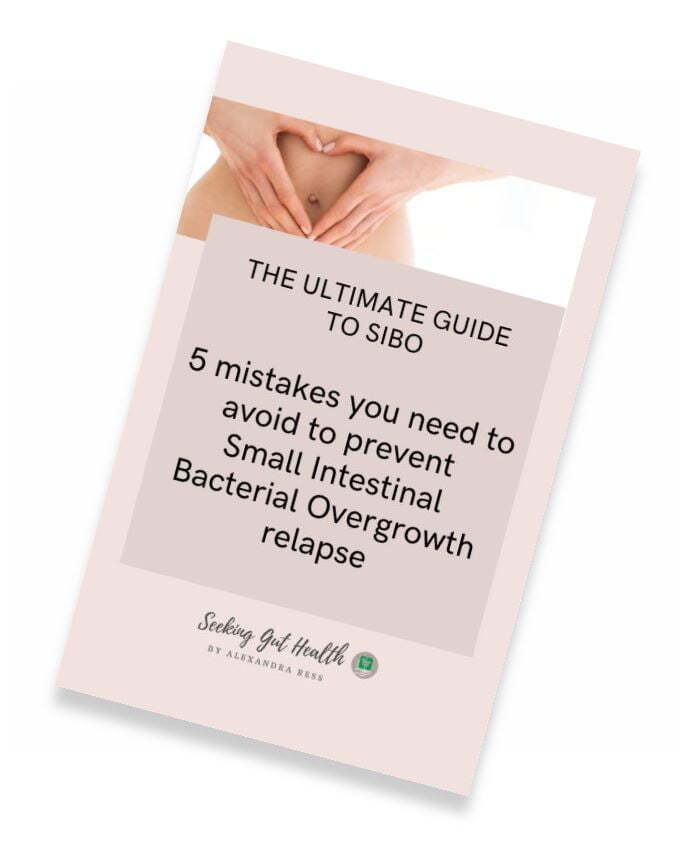
What is Ileocecal Valve?
The ileocecal valve is a sphincter located in the last section of the small intestine (ileum), connecting to the first portion of the large intestine (cecum). It opens to allow the digested food to pass downwards and closes to prevent the backflow of the colonic content or waste to the small intestines (ileum). (1)
What is the connection between Ileocecal Valve and SIBO?
In one of my previous blog posts, I wrote about SIBO (Small Intestinal Bacterial Overgrowth) that it is a digestive disorder when an 𝗶𝗻𝗰𝗿𝗲𝗮𝘀𝗲𝗱 𝗮𝗺𝗼𝘂𝗻𝘁 𝗼𝗳 𝗯𝗮𝗰𝘁𝗲𝗿𝗶𝗮 𝗽𝗿𝗲𝘀𝗲𝗻𝘁 𝗶𝗻 𝘁𝗵𝗲 𝘀𝗺𝗮𝗹𝗹 𝗶𝗻𝘁𝗲𝘀𝘁𝗶𝗻𝗲𝘀. Generally, in the small intestine, there should be less amount of bacteria, but when an overpopulation happens, it leads to different symptoms such as: bloating, gas, diarrhea/ constipation, abdominal pain, skin issues, food intolerances, etc. (2)
To get diagnosed with SIBO, you need to perform a 3-hour lactulose /glucose breath test.
There are many root causes and risk factors that can cause SIBO. Your body has its own defense mechanism to prevent overgrowth; however, when structural problems (adhesions, blind loops), motility disorders (impaired migrating motor complex, medications), or biochemical abnormalities (poor bile flow, low stomach acid, low immunity, thyroid dysfunctions) occur then, it gives the green light to SIBO. An impaired Ileocecal valve function is one of the risk factors that fall under structural issues. (3)
Imagine taking back control of your body and living bloat-free. Download your free guide and learn the 5 MISTAKES you need to AVOID TO PREVENT SMALL INTESTINAL BACTERIAL OVERGROWTH RELAPSE.
Grab your copy today!
What does it mean then the valve is impaired?
It means the valve opens too long and allows waste flow back up to the small intestines resulting in ileocecal valve syndrome (ICVS), which may predispose an individual to SIBO (Small Intestinal Bacterial Overgrowth). (4)
What causes the ileocecal valve syndrome to happen is when the valve gets stuck in an open or closed position. An open ileocecal valve might result in SIBO or diarrhea, while a closed valve in constipation. Besides, gas production by the bacteria may also put further pressure on the valve. (5)
Other symptoms with Ileocecal Valve Syndrome:
- Nausea
- Flu-like symptoms
- Chronic fatigue
- Dizziness
- Ringing in the ears
- Headache
- Right shoulder pain
- Low back pain

What causes the Ileocecal Valve Syndrome?
- Dehydration
- Irritant foods: popcorn, chips, pretzels, nuts, seeds, whole grains
- Stimulants: caffeine products (coffee, black tea), cocoa, chocolate
- Alcohol
- Strong spices: chili, black and cayenne pepper, hot peppers
- Infections (parasitic, fungal, bacterial, viral) – post-infectious IBS that occurs after a food poisoning event, and toxins are released by bacteria that interfere with MMC (migrating motor complex, which is a cleansing wave of the gut)
- Gut dysbiosis (low levels of beneficial bacteria that have also effect on motility)
- Stress and emotional trauma impacting the vagus nerve function
- Unhealthy eating habits (not chewing your food well, eating too fast, too frequently)
- Adrenal imbalances
- Medications(6)
A study has suggested that dysfunction of this valve can contribute to symptoms such as bloating, gas, abdominal pain, constipation/diarrhea, heart symptoms, insomnia, nerve pain, muscle pain, stiffness, etc. (5)
How to maintain a properly functioning ileocecal valve?
- Chiropractic or acupressure treatment
- Ileocecal valve massage
- Mindful eating habits (chewing well, eating slowly)
- Following an anti-inflammatory diet and eliminating the irritating foods from your diet (as mentioned above)
- Using natural supplements such as liquid chlorophyll, HCl with pepsin, choline, calcium, adrenal support (7)
- Treating bacterial overgrowth and other possible infections
- Repopulating the gut with good bacteria using fermented foods or specific pre-and probiotics
This post is only for informational purposes and is not meant to diagnose, treat or cure any disease. I recommend consulting with your healthcare practitioner always before trying any treatment or dietary changes.
Wikipedia contributors. (2021, August 11). Ileocecal valve. In Wikipedia, The Free Encyclopedia. Retrieved 12:44, September 9, 2021, from https://en.wikipedia.org/w/index.php?title=Ileocecal_valve&oldid=1038275457
Rao, S., & Bhagatwala, J. (2019). Small Intestinal Bacterial Overgrowth: Clinical Features and Therapeutic Management. Clinical and translational gastroenterology, 10(10), e00078. https://doi.org/10.14309/ctg.0000000000000078
Achufusi, T., Sharma, A., Zamora, E. A., & Manocha, D. (2020). Small Intestinal Bacterial Overgrowth: Comprehensive Review of Diagnosis, Prevention, and Treatment Methods. Cureus, 12(6), e8860. https://doi.org/10.7759/cureus.8860
Roland, B. C., Ciarleglio, M. M., Clarke, J. O., Semler, J. R., Tomakin, E., Mullin, G. E., & Pasricha, P. J. (2014). Low ileocecal valve pressure is significantly associated with small intestinal bacterial overgrowth (SIBO). Digestive diseases and sciences, 59(6), 1269–1277. https://doi.org/10.1007/s10620-014-3166-7
Miller, L. S., Vegesna, A. K., Sampath, A. M., Prabhu, S., Kotapati, S. K., & Makipour, K. (2012). Ileocecal valve dysfunction in small intestinal bacterial overgrowth: a pilot study. World journal of gastroenterology, 18(46), 6801–6808. https://doi.org/10.3748/wjg.v18.i46.6801
Williams, D. (2016). How to Manipulate Your Ileocecal Valve for Better Health. Link
Sandberg-Lewis, S. (2009). Functional Gastroenterology, Assessing and addressing the causes of functional gastrointestinal disorders (2nd ed.). Portland: NCNM Press.

Alexandra is a Functional Medicine Certified Health Coach & Holistic Nutritionist specializing in IBS, SIBO, and Gut Health. She helps her clients identify the root causes of their chronic gut issues with functional testing, supporting their bodies holistically and implementing the necessary lifestyle changes long-term to regain control of their bodies and enjoy food freedom. Book your FREE SIBO Assessment call now >>>

